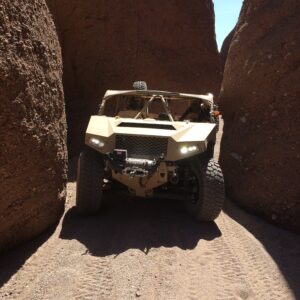
WASHINGTON: It’s six days until the largest defense conference of the year, the Association of the US Army’s annual meeting, and here at Breaking Defense our email runneth over. Amidst the missives touting everything from “e-learning solutions” to free steak dinners for reporters, though, this one in particular caught our eye. On first sight, it’s a good old-fashioned Army truck.

Specifically, it’s Polaris Industries’s DAGOR — the name doesn’t stand for anything the company will admit to — which will be officially unveiled at AUSA. What’s old-fashioned about this truck is that it isn’t burdened down by thousands of pounds of armor (or even doors), in stark contrast to uparmored Humvees and MRAPs that became the lumbering icons of the post-9/11 wars, or even their relatively streamlined replacement, the Joint Light Tactical Vehicle (JLTV).
At two and a quarter tons (4,500 pounds) unloaded, DAGOR is certified as able to fit inside an Army H-47 Chinook or in a sling under the Army’s smaller UH-60 Black Hawk. On landing, it can haul a standard nine-man Army squad at high speed over rough terrain, riding on a suspension inspired by cross-desert racing vehicles called “trophy trucks.” That combination of airborne and cross-country mobility is why DAGOR’s being bought by unspecified “elements of U.S. SOCOM” — presumably Army Special Operations, given the squad size and aircraft it’s certified for — and unnamed “international SOF customers.”
This is a growing market niche: There’s an entirely separate program for an Internally Transportable Vehicle (ITV) to fit on the Marine Corps and Air Force V-22 Osprey, as well as a somewhat larger SOCOM Ground Maneuver Vehicle (GMV) in development. All these vehicle sacrifice armor protection — which grew dramatically in response to roadside bombs — for air-transportability and off-road mobility.
It’s a risky tradeoff, and one the regular Army and Marine Corps seem unwilling to make, given their desire to reconcile protection and mobility in the JLTV. But special operators often live with a higher level of risk and rely on speed, surprise, and elusiveness instead of armor.
Move over FARA: General Atomics pitching new Gray Eagle version for armed scout mission
General Atomics will also showcase its Mojave demonstrator for the first time during the Army Aviation Association of America conference in Denver, a company spokesman said.


























